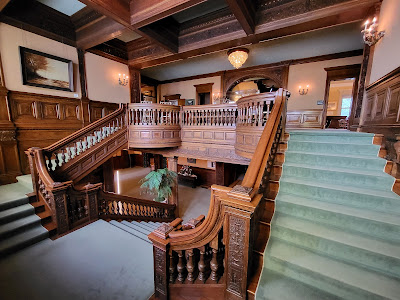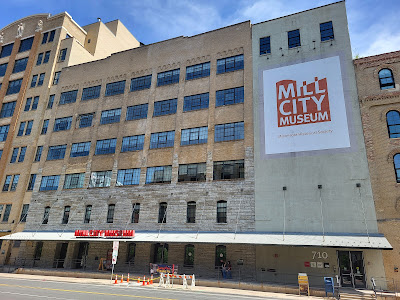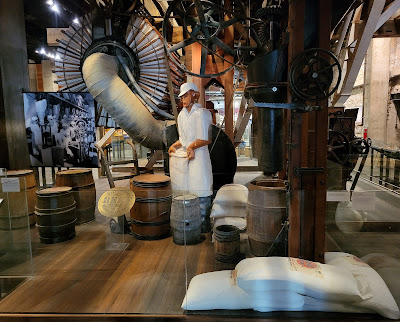We found a small city park in the town of New Richmond, Wisconsin, about 30 miles east of St. Paul. We made Hatfield Park our home base for a week. While there we enjoyed touring Minneapolis/St. Paul. We realized that we were there for the first weekend of the month. Many museums have free Bank of America days the first full weekend of each month. We took advantage of this offer, and we were very busy at the museums our first weekend in the Twin Cities.
JAMES J. HILL HOUSE
St. Paul's largest house was built in 1891 for the Great Northern Railroad titan James J. Hill.
The five-story Gilded Age mansion is 36,000 square feet and was built for under one million dollars.
The extensive woodworking in the house was all custom designed and constructed.
It housed 13 bathrooms, 22 fireplaces and 16 cut-glass chandeliers.
In winter, the central heating system burned two tons of coal per day and could maintain 70 degrees inside while -40 outside.
The music room had a three-story pipe organ by the maker George Hutchings.
THE CATHEDRAL OF SAINT PAUL
The Cathedral of Saint Paul was erected in 1905, directly across the street from the James J. Hill house, at a cost of 1.5 million dollars.
As seen through the front arch of the Hill Mansion.
One of the most distinctive cathedrals in the United States, it sits on Cathedral Hill overlooking downtown Saint Paul and features a distinctive copper-clad dome.
The massive church can seat 3,000 people.
The dome of the cathedral is 76 feet in diameter and 186 feet high.
The hand-carved walnut organ case preserves the view of the cathedral's rose window. Human-sized carved angels stand on both sides of the organ case and a statue of Saint Cecilia, patron saint of music, stands on top of the central organ case dome, directly below the rose window.
Altar of the Cathedral
We stayed for the 5:15 Saturday evening mass and heard the organ.
We walked to the Minnesota History Center. There we looked at some interesting exhibits as well as a section dedicated to the Greatest Generation, covering the depression, WWII, and the boom that followed. Many of the exhibits are interactive and all are very well done.
There was a special exhibition: The Life and Art of Charles M. Schulz.
MILL CITY MUSEUM
Minneapolis was known as the Flour Mill Capitol of the World, a title it held from 1880 to 1930. Mill City Museum is the site of the old Washburn Mill that was once the largest flour mill in the world.
Since it was Sunday of the first weekend, we got into the museum for free.
The packing machine filled barrels and 240-pound bags of flour. After the bags were filled, the men stitched them closed. The Washburn A. Mill could produce 2 million pounds of flour each day. Three hundred boxcars of grain were unloaded each day and reloaded with finished flour.
The tour started with an elevator ride/interpretive exhibit. The elevator stopped at each factory floor, where the doors opened to exhibit the flour production process that occurred at each of seven floors. We exited the elevator on floor number eight, the dust collection floor. This is where flour dust was removed from the air.
We took the stairs to the ninth floor with an overlook of the city, Mississippi River, St. Anthony Falls, and factory.
The Pillsbury plant can be seen across the river. Today both Gold Medal and Pillsbury are part of General Mills.
Washburn Mill, opened in 1874, as seen from river level.
Flour dust led to the Washburn Plant explosion in 1878, killing 18 employees. After rebuilding the plant, fire destroyed the south side in 1928. In 1965 the Washburn Mill permanently closed. After falling into disrepair, fire gutted the abandoned mill in 1991.
MINNEHAHA FALLS
The famous Minnehaha Falls of Minneapolis are in the Minnehaha Park. We stopped by there on a Sunday, and it seemed like everyone in Minneapolis was there.
MALL OF AMERICA
What can you say, this is a BIG MALL. We had to see it.
HISTORIC TOWN OF STILLWATER
The Stillwater Lift Bridge which spans the St. Croix River is now a pedestrian only bridge, linking Wisconsin and Minnesota.
Up she goes.
The bridge is raised and lowered each half-hour to accommodate boat traffic.
We had lunch at The Dock in Stillwater.
Viewpoint at the north end of St. Croix Lake on the St. Croix Scenic Byway.
ST. CROIX RIVER BRIDGE
The new bridge that spans the St. Croix River that run between Wisconsin and Minnesota was built in 2017.
We crossed this bridge each time we commuted to/from New Richmond, Wisconsin, and the Twin Cities.
MINNESOTA STATE CAPITOL IN SAINT PAUL
This is the state's third capitol building, built in 1905.
The exterior of the Capitol is made up of white Georgia marble.
The Capitol Rotunda spans three floors.
The North Star on the first floor is the same as the state flag.
House of Representatives Chamber
Senate Chamber
The guide took us out on the roof of the Quadriga to view the sculpture of a chariot pulled by four horses. It was newly regilded with four pounds of 23.5 karat gold leaf.
COMO PARK ZOO & CONSERVATORY
We toured the Como Zoo and McNeely Conservatory in St. Paul.











































No comments:
Post a Comment